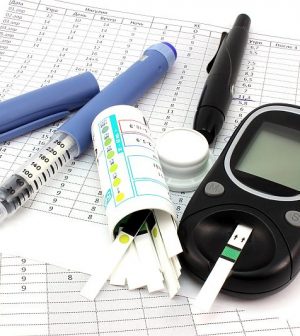- Skip Storing This Everyday Product in the Fridge Door
- Green Tea + B3 Pairing May Boost Brain Health
- Navigating Your Midlife Crisis: Embracing New Possibilities
- City Raccoons Showing Signs of Domestication
- Mapping the Exposome: Science Broadens Focus to Environmental Disease Triggers
- One Week Less on Social Media Linked to Better Mental Health
- Your Brain Changes in Stages as You Age, Study Finds
- Some Suicide Victims Show No Typical Warning Signs, Study Finds
- ByHeart Formula Faces Lawsuits After Babies Sickened With Botulism
- Switch to Vegan Diet Could Cut Your Greenhouse Gas Emissions in Half
Insurance Gaps Costly for Those With Type 1 Diabetes

Gaps in private insurance coverage are common among American adults with type 1 diabetes, raising their risk for health crises, a new study finds.
“Type 1 diabetes requires intensive daily management in order to simply remain alive, so interruptions to care and coverage of insulin and supplies can pose a major risk,” said study leader Mary Rogers. She’s a research associate professor at the University of Michigan.
In people with this chronic condition, the pancreas produces little or no insulin, a hormone needed to regulate blood sugar. About 1.25 million Americans have the disease.
The researchers analyzed data collected from early 2001 to mid-2015 from nearly 169,000 adults, ages 19 to 64, with type 1 diabetes.
One-quarter of them had at least one gap of 30 days or more in their private health insurance over an average period of three years.
With coverage gaps of 30 to 60 days, patients were five times more likely to end up in an emergency room, hospital or urgent care center once they regained coverage. After a gap of 91 to 120 days, that risk was more than seven times higher than before the coverage gap, the study found.
“While we expected gaps in coverage to affect health in some way, the size of the effect and the frequency of gaps were striking,” Rogers said in a university news release.
Patients in their 20s and 30s were more likely to have coverage gaps than those in their 40s, 50s and early 60s. And people in the north central and southern part of the country were more likely to have a gap than those in the Northeast or West, according to the study.
The acute health care required after coverage gaps “are costly, and largely preventable with regular self-care guided by a primary care physician or an endocrinologist — a specialist who treats patients with diabetes,” Rogers said.
“While we did not examine direct costs, each emergency visit or hospitalization can easily cost thousands of dollars,” she said.
Rogers added that patients with type 1 diabetes also face rising insulin costs, which have more than tripled in the past two decades.
“Our study provides evidence of fragmented care for adults with type 1 diabetes in the United States,” Rogers said.
“Such gaps in health care have been noticed for people who go in and out of Medicaid coverage, but we report that it also occurs in adults who have private health insurance,” she said.
Providing continuity of care for patients with diabetes is associated with lower mortality, Rogers noted.
“This problem is not going away. If anything, fragmented care is likely to increase with projected trends,” she said.
The study findings are published in the July issue of the journal Health Affairs.
More information
The American Diabetes Association has more on type 1 diabetes.
Source: HealthDay
Copyright © 2025 HealthDay. All rights reserved.










